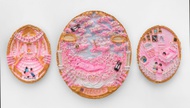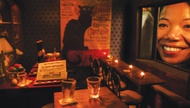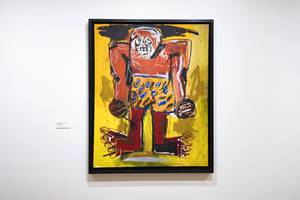
Axis Mundo: Queer Networks in Chicano L.A. Through March 16; Monday-Friday, 9 a.m.-5 p.m. (Thursday until 8 p.m.); Saturday, noon-5 p.m. UNLV's Marjorie Barrick Museum of Art, 702-895-3381.
The Axis Mundo: Queer Networks in Chicano L.A. is a game-changing show at the Barrick Museum with a colossal 400 multimedia artworks by more than 50 artists who may or may not be queer, may or may not be Chicano/a, and may or may not have worked exclusively in LA between 1960 and 1990. That’s where the “axis mundo” (world axis) comes in. The network of these artists pings Las Vegas, New York City, San Francisco and points beyond with pieces that intrigue, entertain, provoke and enthrall. All the more poignant that curators C. Ondine Chavoya, professor of art history and Latina/o studies at Williams College; and David Evans Frantz, associate curator of Palm Springs Art Museum; rescued some of the art from obscurity and potential destruction.
Anchoring the exhibition is the wunderkind from East LA himself, Mundo Meza. Although Meza worked just a decade and a half before being felled by AIDS at age 29, he literally made his mark as a performer/window dresser/fine artist and denizen of the LA queer scene. Axis Mundo honors both his art—23 of his pieces exhibited together for the first time—and their context.“Portrait Study,” for example, with its slate of geometric symbols in lieu of a face, summons Surrealism and Cubism. But the spectral “Self Portrait,” painted in acrylic the same year, takes a completely different tack, borrowing from British figuration and Abstract Expressionism, while the earlier “Wig Shop” opts for a vibrant political allegory in colored pencil. Meza’s dexterity with a host of artistic styles is more than exploratory: It’s expert. Evidence suggests that if Meza had lived longer, he might have catapulted from underground sensation to mainstream icon.
Among other standouts are Carlos Almaraz’s witty suite of minimalist collages. Working on graph paper with fragmented images, Almaraz intimates a kind of narrative algebra, the background grid seemingly supplying the missing links, e.g., male statue + elephant + gun + partial female body + sign = mating crisis. Tosh Carrillo’s photos, too, are among the stunners. Printed and exhibited for the first time in Mundo, the black and white portraits have a staged quality that’s secondary to the tenderness revealed in the subjects. Some of the faces disarm with a candid vulnerability, while others harbor a mysterious, inner knowing.
Axis Mundo is an ambitious show, its artistic genres as intersectional as the show’s communities. Drawings, watercolors, zines, videos, posters, prints, photographs, clothing, painting and a fascinating trove of mail art are all on display, with many works reacting or alluding to other artists and artworks. Stories of human lives take over. Experiencing Axis Mundo is to enter the rabbit hole and find out how connected everything is. It’s not Queer Chicanx history. It’s everybody’s history.






